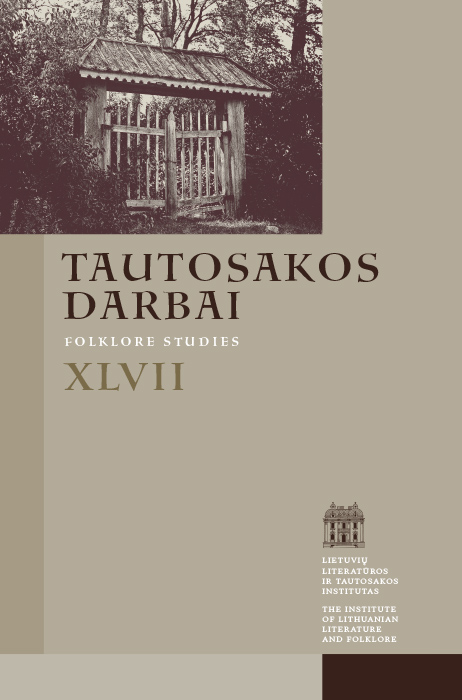The Lopaičiai Landscape from the Historical and Modern Perspective
Abstract
Recently, various tendencies of renewal of the cultural landscape can be observed, including purposeful formation of new territorial complexes, incorporation of separate objects into the landscape or simple endowing of landscape with new meanings by imbuing it with different cultural and historical contents. In this article, one such space endowed with new meanings is introduced from the folkloristic perspective, namely, the so-called ethno-mythological complex in Lopaičiai, where a new “Samogitian” version of the pre-Christian Lithuanian history was materialized at the beginning of the 21st century. First, on the Lopaičiai mound a hitherto not localized (although mentioned by some historical sources) castle of Tviremet by an obscure Samogitian duke Vykintas was decided to have stood, and afterwards, theories devoid of any factual background started to spread about a pre-Christian sacral place having allegedly existed nearby the Lopaičiai mound, which was dubbed the Samogitian spiritual center. In this case, actualization of the glorious past is performed by means of the landscape, in order to ground the right of the ethnic Samogitian group to its cultural and political emancipation during the period of political change; this glorious past is also attempted to make use of in development of the cultural tourism by way of adorning this place with deceptive veil of antiquity and assumed sacrality.
Such speculative and doubtful theories enjoying considerable spread by mass media not only acquired status of reality in the eyes of various social groups (esoteric, bioenergetic, neo-pagan, etc.), but also inevitably merged into the present life of the local community, including self-reflections of the inhabitants of a nearby township of Tverai and the surrounding villages. The article reveals patterns of reflecting over the new meanings ascribed to the Lopaičiai mound by the local narrator belonging to the elder generation, in whose memory this space had hitherto been affiliated with quite different connotations of the historical past. For the analysis, narratives elucidating the historical paradigm have been selected. This data allows concluding that real or assumed historical facts and storylines actualized by the public communication are accepted not recklessly, but rather by attempting to connect the newly ascribed meanings of the landscape to the past and the individual experience; the latter constituting the borderline that purposefully promoted interpretation of the past is incapable of transgressing. Besides, various texts and contexts originating in the folk culture are attempted to incorporate into the modern narrative by one way or another, also constituting the background (although invalid in this case) for the interpretations failing to reach the scientific standards.
Downloads
Most read articles by the same author(s)
- Vilma Daugirdaitė, Editorial Board and Table of Contents , Tautosakos darbai: Vol. 65 (2023): Tautosakos darbai
- Vilma Daugirdaitė, Rūta Pleskačiauskienė, Ambraziejus Jonynas: the Bibliographic Index, 1937–2019 , Tautosakos darbai: Vol. 63 (2022)
- Vilma Daugirdaitė, Author guidelines and Bibliographic Data , Tautosakos darbai: Vol. 65 (2023): Tautosakos darbai
- Vilma Daugirdaitė, Folkloristics in the Independent Lithuania (1918–1940): Outlining the History , Tautosakos darbai: Vol. 50 (2015)
- Vilma Daugirdaitė, “Since Then, People Started Thinking about This Mountain in a Different Way”. From Jonas Kumetis’ Memories about the Veliuona Hillforts , Tautosakos darbai: Vol. 64 (2022)
- Vilma Daugirdaitė, Aukusti Robert Niemi and His Collection of Folklore from Southern Lithuania Revisited. Textological Approach , Tautosakos darbai: Vol. 55 (2018)
- Vilma Daugirdaitė, Full bibliography of Tautosakos darbai / Folklore studies: 1935 – 2015 (Vols. 1 – 50) , Tautosakos darbai: Vol. 50 (2015)
- Vilma Daugirdaitė, Past and Present of Lopaičiai as Viewed by the Local People , Tautosakos darbai: Vol. 47 (2014)
- Vilma Daugirdaitė, Editorial Board and Table of Contents , Tautosakos darbai: Vol. 66 (2023): Tautosakos darbai
- Vilma Daugirdaitė, Foreword , Tautosakos darbai: Vol. 47 (2014)
